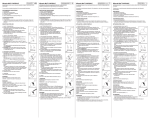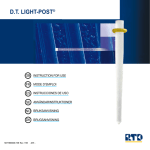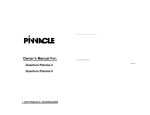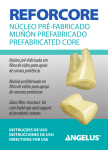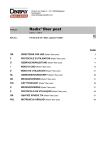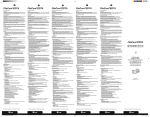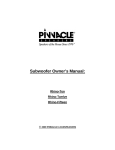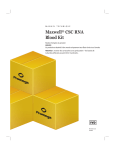Download INSTRUCTIONS FOR USE MODE D`EMPLOI
Transcript
5. GB 6. INSTRUCTIONS FOR USE DESCRIPTION 2 stage parallel design for optimum retention and adaptation. LIGHT-POST® is a radiopaque translucent quartz fiber post. The radio-opacity level of the LIGHT-POST® is respectively about 1.8 and 2 mm Al (ISO 4049). ■ 1 ■2 ■3 Ø apical tip 0.65 0.85 0.85 Ø 1 St stage 1.00 1.20 1.40 Ø 2 St stage 1.40 1.80 2.10 ■ ■ Color coding Red Grey ■ Blue INDICATIONS FOR USE In case of insufficient residual tooth structure (<4 mm), the post is needed to support and secure the coronal restoration. CONTRAINDICATIONS If coronal tooth structure is less than 1.5 mm. PRECAUTIONS The post must be cleaned with alcohol before insertion in the canal. Avoid touching the posts with your fingers after cleaning. Shortening the post should be done outside of the mouth. The use of rubber dam is recommended. The crown must cover the preparation of at least 1.5 mm of healthy dentin in order to get the ferrule effect. ADVERSE REACTIONS None known to date. STEP-BY-STEP INSTRUCTIONS 1. Root canal preparation: remove gutta-percha to 2. 3. 4. preplanned depth with a Gates-Glidden, Peeso reamer or Largo. Radiographic verification is recommended. Select the correct LIGHT-POST® post size. Determine the post size according to the anatomical situation of the tooth using the radiograph and the plastic calibrating card. Determine the length of the coronal build-up, which will account for 1/3 of the final post length. Remove the root filling with the Torpan70 (rotation speed 1000-2000 rpm) as deep as necessary for the post to be inserted to 2/3 of the root length. In case of curved canal, this calculated length is not suitable. At least 4 mm of root canal filling should remain in the apical region. Complete the preliminary preparation with the selected preshaping drill (rotation speed 1000-2000 rpm). Shape the canal with the Finishing Drill LIGHT-POST® corresponding to the selected LIGHT-POST® size, (rotation speed 1000-2000 rpm). NOT0800XX00-201301-07.indd 1-6 7. 8. 9. Try in the post, to check that the post is properly seated in the canal For LIGHT-POST® position the colored O-ring as a cutting mark and then remove post. Shorten the post to its final length with a diamond disc outside of the mouth. Never use a crimping instrument, such as wire cutters, as the pressure can destroy the structure of the post. Remove the O-ring. Clean the post with alcohol. Apply etchant in the post space and to the exposed dentin for 15 seconds*. Rinse for 10 seconds. Remove the excess water with paper points but leave surface moist. Do not put the etchant in contact with the gingiva. Apply 2 coats* of the primer with a thin brush (e.g. Composibrush RTD) in the post space. Remove excess using paper points and gently air dry all surfaces. Enamel and dentin surfaces should have a uniform, glossy appearance. If not, repeat application. Light-cure the primer* inside the post space for 10 to 20 seconds. 10. Apply a single coat of primer* to the post. Gently air dry 5 seconds and light-cure the post for 10 to 20 seconds (if needed) outside the mouth. 11a. If using a dual cure resin cement for both cementation and core build up such as Corecem™ (recommended technique): Mix the cement and apply it in the post space from bottom to the top using the root canal tips. Seat the post immediately. Light-cure for 40 to 60 seconds. Continue applying the core build up using a plastic Coreform™ matrix, or directly on the tooth. 11b. If using separate cement and a core build up resins : Mix the cement* and apply it to the post and then in the post space using a Lentulo spiral or a syringe tip. Seat the post immediately. Remove excess cement with appropriate instruments. If using dual-cure cement, light-cure for 40 to 60 seconds, applying gentle pressure on the post with the tip of the curing light probe. Apply 2 coats of bonding agent* to the exposed post(s), cement and involved tooth structure. Remove excess and air-dry with jet of air. Light-cure for 20 seconds (if needed). 11c. If using a self etching cement*, there is no need to etch and prime the post space. Mix the cement and apply it in the post space from bottom to the top using a root canal tip. Seat the post immediately. Remove excess cement. Light cure if needed. After etching, rinsing, drying, apply 2 coats of bonding agent* to the exposed post(s), cement and involved tooth structure. Remove excess and air dry with jet of air. Light cure for 20 seconds (if needed). 12. Directly model the build-up using a composite core build-up material*. R.T.D. recommends that the coronal end of the post be covered by core composite. OTHER RECOMMENDATIONS ® LIGHT-POST are single use devices. They must not be reused to avoid the risk of contamination. LIGHT-POST® can be cleaned with alcohol. They can neither be sterilised nor disinfected in thermodisinfector. LIGHT-POST® can be sterilized individually in an autoclave with the following settings**: • Wrap individually in disposable sterilization pouches or tubing that comply with the regulation standard in force in the country of use (e.g EN ISO 11607-1), • Autoclave: type B complying with regulation standard in force (e.g EN 13060), MANUFACTURER : RTD 3 rue Louis Neel 38120 St Egrève - France www.rtd.fr [email protected] • Sterilization temperature: 134°C - sterilization time: 18 minutes, FR • 1 cycle only. A LIGHT-POST® re-access kit is available if needed. Contact your RTD distributor. PRESHAPING DRILL LIGHT-POST® and Finishing Drill LIGHTPOST®: these instruments are supplied non-sterile. Disinfect and sterilize instruments before each use. Disinfect instruments with disinfecting or cleaning agents adapted for rotary instruments*. Do not disinfect instruments in thermodisinfector. Inspect instruments visually before each use: change to new drills when they are damaged, corroded or dull. The finishing drills may be used only to prepare root canal. LIGHT-POST® drills must be sterilized individually in an autoclave with the following settings**: MODE D’EMPLOI DESCRIPTION Forme à double rétention cylindrique et à deux étages coniques de stabilisation, longueur 19 mm. LIGHT-POST® est un tenon radio-opaque et translucide en fibres de quartz. Le niveau de radio-opacité des tenons LIGHT-POST® est de 1.8 à 2 mm Al (ISO 4049). • Wrap individually in disposable sterilization pouches or tubing that comply with the regulation standard in force in the country of use (e.g EN ISO 11607-1), • Autoclave: type B complying with regulation standard in ■ 1 ■2 ■3 Ø pointe 0.65 0.85 0.85 Ø intermédiaire 1.00 1.20 1.40 force (e.g EN 13060), Ø tête 1.40 1.80 2.10 18 minutes. Codage couleur ■ ■ • Sterilization temperature: 134°C - sterilization time: Use a new drill after 12 -15 uses. Rouge Gris ■ Bleu For profoundly flared or ovoid canals, the use of accessory post, such as Fibercone™, is indicated for best results. INDICATIONS STORAGE Le tenon sert de support à la restauration coronaire en cas de substance dentaire résiduelle inférieure à 4 mm. Store the sterilized components in a dry, dust-free place. If the packaging’s integrity appears to be compromised, before using again, place the component in a new pouch ad re-sterilize according to the protocol defined before. SAFETY AND LIABILITY WARRANTY RTD warrants this product will be free from defects in material and manufacture. RTD makes no other warranties including any implied warranty of merchantability or fitness for a particular purpose. User is responsible for determining the suitability of the product for user’s application. If this product is defective within the warranty period, your exclusively remedy and RTD’s sole obligation shall be repair or replacement of the RTD product. LIMITATION OF LIABILITY Except where prohibited by law, RTD will not be liable for any loss or damage arising from this product, whether direct, indirect, special, incidental or consequential, regardless of the theory asserted, including warranty, contract, negligence or strict liability. Selection of the correct drill and post is the responsibility of the user. For dental use only. * Refer to the manufacturer’s instructions for use. ** Please refer to your autoclave manufacturer for specific sterilization instructions if needed CONTRE-INDICATIONS Parois dentinaires inférieures à 1.5 mm au niveau coronaire. PRECAUTIONS D’EMPLOI Le tenon doit être nettoyé à l’alcool avant toute insertion dans la bouche du patient. Ne pas toucher le tenon avec vos mains. Le tenon doit être coupé à l’extérieur de la bouche du patient. L’usage de la digue est recommandé. Le recouvrement prothétique doit être d’au moins 1.5 mm de structure dentaire saine pour obtenir l’effet de sertissage désiré (Ferrule effect). EFFETS SECONDAIRES Aucun effet secondaire connu à ce jour. PREPARATION PAS-A-PAS 1. Préparation canalaire : retirer la gutta-percha à la pro- 2. 3. fondeur prévue avec un foret Gates-Glidden, alésoir Peeso ou Largo. Une vérification radiographique est recommandée. Choisir le tenon LIGHT-POST® adapté à l’anatomie du canal d’après l’analyse radiographique. Déterminer la hauteur du faux-moignon : elle devra être 1/3 de la longueur totale du tenon. Retirer l’obturation radiculaire avec le Torpan 70, (1000−2000 t.min−1). Préformer le canal radiculaire avec le foret PRESHAPING DRILL LIGHT-POST® correspondant, (1000-2000 t.min-1), afin de permettre au tenon d’être inséré sur 2/3 de la longueur radiculaire. Dans le cas de canaux très courbés, il n’est pas toujours possible d’atteindre cette longueur. Il doit rester un minimum de 4 mm d’obturation jusqu’à l’apex. Préparer le canal radiculaire adapté au tenon choisi avec le foret FINISHING DRILL LIGHT-POST® correspondant (1000-2000 t. min-1 ) . 4. Vérifier que le tenon est bien ajusté au canal ainsi préparé. 5. Raccourcir le tenon à la longueur adéquate avec un disque diamanté. Déplacer le codage couleur et l’utiliser comme repère de coupe. Ne pas utiliser de pinces, car la pression exercée risque de détruire la structure du tenon. Retirer le codage couleur. 6. Nettoyer le tenon à l’alcool. 7. Mordancer le canal et la partie coronaire pendant 15 secondes*. Rincer le canal pendant 10 secondes et le sécher légèrement avec des pointes de papier. Les parois canalaires doivent rester humides. Eviter tout contact avec la gencive. 8. Appliquer 2 couches d’adhésif* sur la préparation à l’aide de l’applicateur de type Composibrush RTD. Retirer l’excès de produit avec des pointes de papier. Sécher légèrement avec un jet d’air. La surface canalaire doit avoir un aspect lisse et brillant. Si tel n’est pas le cas, renouveler l’application. Photo-polymériser l’adhésif* dans le canal pendant 10 à 20 secondes. 9. Appliquer une seule couche d’adhésif* sur le tenon. Sécher 5 secondes avec un jet d’air. Photo-polymériser pendant 10 à 20 secondes (extra oral) si nécessaire. 10a. Cas d’une utilisation avec le même produit comme ciment et composite de reconstitution tel que le Corecem™ (technique recommandée). Mélanger le ciment-composite et remplir le canal de bas en haut à l’aide de l’embout « root canal tip ». Insérer le tenon immédiatement. Photo-polymériser pendant 40-60 s. Continuer la préparation du faux-moignon soit en appliquant directement soit en remplissant une matrice plastique Coreform™. 11b. Cas d’une utilisation avec deux produits séparés : un ciment et un composite pour faux-moignon. Mélanger le ciment* et remplir le canal à l’aide d’un Lentulo ou d’une seringue à injecter. Insérer le tenon immédiatement. Enlever l’excès du ciment à l’aide d’instruments appropriés. Photo-polymériser pendant 40-60 s dans le cas d’un ciment dual en maintenant l’embout de la lampe contre le tenon. Appliquer deux couches d’adhésif* sur la partie émergente du tenon et les parois dentinaires. Enlever l’excès à l’aide d’un léger jet d’air. Photo-polymériser pendant 20 s à nouveau si nécessaire. 11c. Cas d’utilisation d’un ciment auto-mordançant. Il n’est pas utile d’appliquer un mordançage et un adhésif dans le canal. Mélanger le ciment et remplir le canal de bas en haut à l’aide de l’embout « root canal tip ». Insérer le tenon immédiatement. Enlever les excès de ciment. Photo-polymériser si nécessaire. Après mordançage, rinçage et séchage, appliquer 2 couches d’adhésif* sur la partie émergente du tenon et les parois coronaires. Enlever l’excès à l’aide d’un léger jet d’air. Photopolymériser si nécessaire. 12. Reconstituer le moignon avec un matériau composite*. RTD recommande que la partie coronaire du tenon soit recouverte par le composite. AUTRES RECOMMANDATIONS Les tenons LIGHT-POST® sont des dispositifs à usage unique. Ils ne doivent pas être ré-utilisés pour éviter tout risque de contamination. Les tenons ne peuvent être ni stérilisés, ni purifiés au désinfecteur thermique. Ils doivent être nettoyés préalablement à l’alcool. Les tenons LIGHT-POST® peuvent être stérilisés individuellement par autoclave selon les paramètres suivants** : • Conditionner individuellement dans les sachets ou gaines de stérilisation à usage unique conforme à la réglementation nationale du pays (exemple EN ISO 11607-1), • Autoclave: type B conforme à la réglementation en vigueur (exemple EN 13060), • Température stérilisation : 134°C - Temps de stérilisation : 18 minutes, • 1 cycle maximum. Un kit de réaccès canalaire est disponible en cas de besoin. Contacter votre distributeur. Forets PRESHAPING DRILL LIGHT-POST® et Finishing Drill LIGHT-POST® : les instruments sont livrés non stériles. Stériliser avant chaque utilisation. Désinfecter les instruments avec des solutions* de rinçage adaptées aux instruments rotatifs. Ne pas désinfecter les instruments au désinfecteur thermique. Contrôler visuellement les instruments avant chaque utilisation : changer les instruments lorsqu’ils sont endommagés, corrodés ou émoussés. Les forets de finition ne devront être utilisés que pour préparer les canaux radiculaires. Les forets doivent être stérilisés individuellement par autoclave selon les paramètres suivants** : • Conditionner individuellement dans les sachets ou gaines de stérilisation à usage unique conforme à la réglementation nationale du pays (exemple EN ISO 11607-1), • Autoclave: type B conforme à la réglementation en vigueur (exemple EN 13060), • Température stérilisation : 134°C - Temps de stérilisation : 18 minutes. Changer de foret après 12 à 15 utilisations. Pour des canaux très aplatis ou ovoïdes, l’utilisation des tenons accessoires tels que le Fibercone™ est recommandée pour un meilleur résultat. STOCKAGE Conserver les produits stérilisés dans un endroit sec, à l’abri de la poussière. Avant réutilisation, en cas de non conformité de l’intégrité de l’emballage, re-conditionner et re-stériliser selon le protocole défini. SECURITE ET RESPONSABILITE GARANTIE RTD garantit ce produit contre tous défauts de matière et de fabrication. RTD n’offre aucune autre garantie, ni aucune garantie implicite ou de qualité marchande ou d’adéquation à un usage particulier. Il revient à l’utilisateur de s’assurer que les produits sont bien destinés à l’usage recherché. Si ce produit s’avère défectueux pendant la période de garantie, votre seul recours et la seule 06/06/13 16:54 A l’exception des lieux où la loi l’interdit, RTD ne sera tenu responsable d’aucune perte ou dommage découlant de ce produit, qu’ils soient directs, indirects, spécifiques, accidentels ou consécutifs, quels que soient les arguments avancés, y compris la garantie, le contrat, la négligence ou la stricte responsabilité. L’utilisateur est seul responsable du choix de la taille appropriée pour le foret et le tenon. Produit à usage dentaire uniquement. * Se reporter aux instructions du fabricant. ** Se reporter aux consignes spécifiques de stérilisation fournies par le fabricant. FABRICANT : RTD 3 rue Louis Neel 38120 St Egrève - FRANCE www.rtd.fr [email protected] SU / NO / DK BRUKSANVISNING/BESKRIVNING Parallell design för optimal retention och adaption. COMPOSIPOST är ett röntgenkontrasterande kolfiberstift/kullfiberstift med 19mm längd/lengde. LIGHT-POST är ett röntgenkontrasterande translucent kvartsfiberstift. Graden av röntgenkontrast för COMPOSIPOST och LIGHTPOST är 1.5 respektive 1.25 mm Al (ISO 4049). ■ 1 ■2 ■3 Dimension 0.65 0.85 0.85 1:a del 1.00 1.20 1.40 2:a del 1.40 1.80 2.10 ■ ■ Färgkodning Red Grey ■ Blue INDIKATIONER I fall/tilfeller med otillräcklig/utilstrækkelig mängd kvarvarande/ gjenværende tandsubstans (<4mm) behövs stiftet för att stödja och säkerställa den koronala restaurationen. KONTRAINDIKATIONER Otillräcklig/Utilstrækkelig mängd kvarvarande/gjenværende tandsubstans (<1.5mm) kring/omkring preparationen. REKOMMENDATIONER Använd dualhärdande eller självhärdande/kemisk hærdende primer/adhesive vid användning av icke-transluscenta stift. VARNINGAR Stiftet måste/skal vara väl rengjort i alkohol före cementering. Undvik att vidröra/ta/røre på stiftet med fingrarna efter att detta har rengjorts i alkohol. Oljan som finns på fingrarna kan påverka bondingstyrkan. Använd handskar eller pincett. Korrigering av stiftets längs skall göras utanför patientens mun. Användning av kofferdam rekommenderas. NOT0800XX00-201301-07.indd 7-12 Kronan behöver omsluta pelarpreparationen med minimum 1.5 mm ner över friskt dentin för att erhålla/beholde den omkramande önskade effekten. ANDRA REKOMMENDATIONER TILLVERKARE: AVVIKANDE REAKTIONER D.T.-stift är engångsartiklar. De får inte återanvändas på grund av kontamineringsrisken. D.T.-stift kan rengöras med alkohol. De kan vare sig steriliseras eller desinficeras i en värmedesinfektor. RTD 3 rue Louis Neel Technoparc Espace Gavavière 38120 St Egrève - Frankrike Inga kända. STEGVISA INSTRUKTIONER 1. Preparera rotkanalen 2. Välj det mest lämpliga stiftet. Bestäm stiftets storlek i förhållande till tandens anatomi. Använd röntgen vid behov. 3. Bestäm höjden på den koronala pelaruppbyggnaden. Denna bör utgöra ca 1/3 av hela stiftets längd. Ta bort kvarvarande rotfyllning med Torpan 70 borr (rotationshastighet: 1000-2000 varv/min) så djupt att stiftet kan placeras i kanalen till ca 2/3 av sin totala längd. Efter preparationen skall minst 4 mm av rotfyllningen lämnats kvar apikalt i kanalen. I fall/tilfeller med böjda rotkanaler kan ovanstående riktlinjer inte tillämpas/følges helt. 4. Gör klart rotrymningen med rotrymmare i vald/utvalgt storlek. (rotationshastighet: 1000-2000 varv/min). 5. Forma rotkanalen med valt slutborr för att anpassa/tilpasse den till det valda stiftet. (rotationshastighet: 10002000 varv/min). 6. Prova det valda stiftet i kanalpreparationen för att se att det sitter ordentligt i kanalen. 7. Vid användning av LIGHT-POST skall den färgade o-ringen placeras som markering för senare avkapning av stiftet. Korta stiftet till önskad längd genom kapning med en diamanttrissa utanför patientens mun. Använd inte avbitartång eller dylikt eftersom detta kan skada strukturen i stiftet. Ta bort o-ringen. 8. Rengör stiftet med alkohol. 9. Applicera etsgel både i rotkanalen och på det koronala dentinet under/i 15 sekunder*. Spola/Skyll bort etsgelen under 10 sekunder. Ta bort överskottsvatten med papperspoints, men lämna ytorna/overflatene fuktade. Undvik att etsgelen kommer i kontakt med gingival vävnad. 10. Applicera 2 skikt/lag* av primer med en tunn pensel (ex. Composibrush RTD) i rotkanalen. Ta bort överskottsmaterial med papperspoints och luftblästra försiktigt alla ytor. Emalj- och dentinytor skall nu ha en glänsande yta. Om detta inte är fallet skall proceduren upprepas. Ljushärda primern* inne i rotkanalen under/i 10-20 sekunder. 11. Applicera ett skikt av primer på det valda stiftet och luftblästra försiktigt under 5 sekunder. Ljushärda stiftet under/i 10-20 sekunder (vid behov) utanför patientens mun*. 12. Blanda cementet* och applicera detta i rotkanalen och på stiftet. Använd en Lentulonål eller tunn kanyl. Placera omedelbart stiftet i kanalen. Ta bort överskottsmaterial med lämpligt/egnet instrument. Om dualhärdande cement används skall detta ljushärdas under/i 40-60 sekunder. Pressa försiktigt med ljusspetsen mot stiftet under härdningen. 13. Applicera 2 skikt av adhesiv* på den synliga delen av stiftet, cement och koronalt dentin. Ta bort överskottsmaterial och luftblästra försiktigt. Ljushärda under/i 20 sekunder.(vid behov) 14. Bygg direkt upp pelardelen med ett kompositmaterial (core build-up material)*. www.rtd.fr [email protected] LIGHT-POST® D.T.-stift kan steriliseras enskilt i en autoklav med följande inställningar**: • Enskilt inslagna i engångssteriliseringsfickor eller -tuber som uppfyller gällande regelstandarder i användningslandet (till exempel EN ISO 11607-1), • Autoklav: typ B som uppfyller gällande regelstandard (till exempel EN 13060), • Steriliseringstemperatur: 134°C - steriliseringstid: SUGGESTED POST SIZE FOR EACH TOOTH (GUIDELINES ONLY) / SUGGESTION POUR LE CHOIX DU TENON / REKOMMENDERAD STORLEK/STØRRELSE PÅ STIFT FÖR VARJE Tr a n s l u c e n t q u a r t z f i b e r TAND (ENDAST VÄGLEDNING) GB INSTRUCTION FOR USE FR MODE D’EMPLOI 18 minuter, • Endast 1 cykel. A D.T.-åtkomstsats finns tillgänglig vid behov. Kontakta din RTD-distributör. D.T.-universalborr och D.T.-putsborr: dessa instrument levereras icke-sterila. Desinficera och sterilisera instrumenten före användning. Desinficera instrumenten med desinficeringseller rengöringsmedel anpassade för roterande instrument*. Desinficera inte instrumenten i värmedesinfektor. Inspektera instrumenten visuellt före varje användning: byt till nya borrar om de är skadade, korroderade eller slöa. Universalborren får endast användas för att delvis ta bort rotkanalfyllningen och putsborrar får bara användas för att förbereda rotkanalen. D.T.-borrar kan steriliseras enskilt i en autoklav med följande inställningar**: • Enskilt inslagna i engångssteriliseringsfickor eller -tuber som uppfyller gällande regelstandarder i användningslandet (till exempel EN ISO 11607-1), • Autoklav: typ B som uppfyller gällande regelstandard (till exempel EN 13060), • Steriliseringstemperatur: 134°C - steriliseringstid: 18 minuter. Byt till ny borr efter 12-15 användningar. För koniska eller äggformade kanaler rekommenderas användning av stödstift, till exempel Fibercone™, för bästa resultat. SE NO BRUKSANVISNING DK LAGRING Lagra de steriliserade komponenterna på en torr och dammfri plats. Om förpackningen verkar skadad vid nästa användning ska komponenten placeras i en ny ficka och steriliseras på nytt enligt protokollet som tidigare definierades. SÄKERHET OCH ANSVAR - RTD tar inget ansvar och ger ingen kompensation för möjliga skador som uppstått till följd av: - användning av instrument som inte tillhör systemet och som kan nedsätta funktionen, att instruktioner inte följts. Användaren har ansvar att testa materialet för dess lämplighet för användning i annat syfte än det som uttryckligen anges i användarinstruktionerna. Det är användarens ansvar att välja rätt borr och stift. Endast för dental användning. * hänvisning till tillverkarens/ producentens bruksanvisning. Rev.:2013-01 RESPONSABILITÉ | 0459 -2005- NOT0800XX00-201301 obligation de RTD sera le remplacement du produit RTD. 06/06/13 16:54



